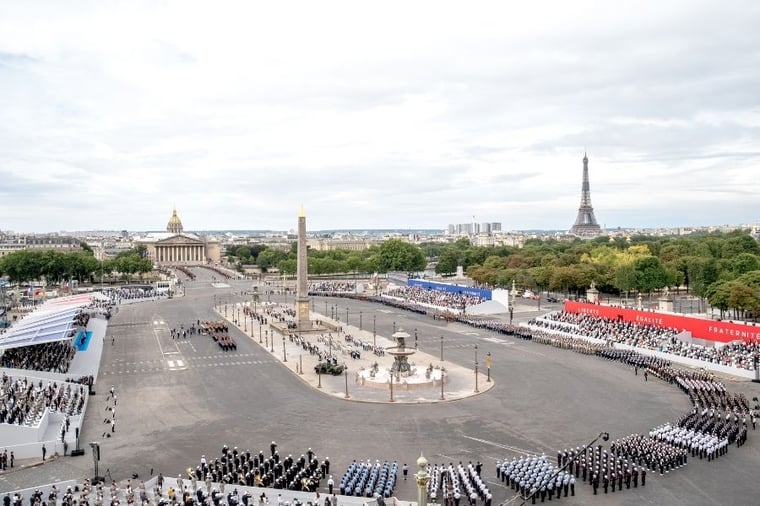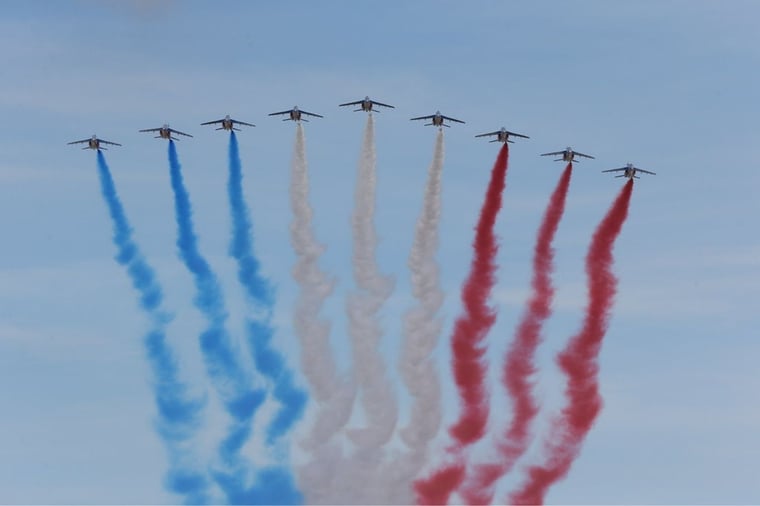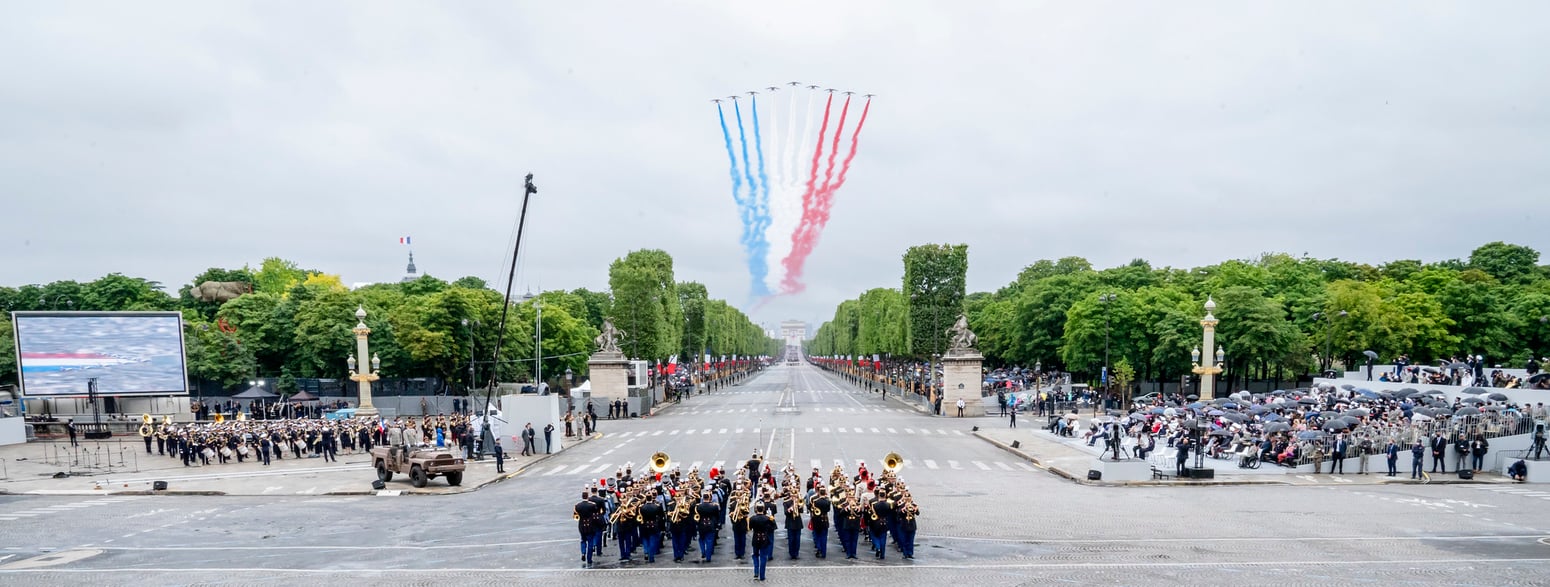Every year since 1880, the French Republic celebrates the Nation in the middle of July. What exactly does it celebrate? How was the date chosen? What does it involve?

14 July 1789
The storming of the Bastille, from the revolt of the Ancien Régime to the revolutionary myth
The Bastille has captured the public imagination, who have made it a formidable symbol of royal absolutism and arbitrary judicial power, full of the cries of the countless prisoners languishing in the shadows of impenetrable walls, with no hope of freedom. In truth, this fortress was built by King Charles V to guard Porte Saint-Antoine, one of the gates of Paris, and was for a time used as a prison, before its importance gradually waned during the eighteenth century. When the fortress was conquered, or simply handed over following the surrender of its garrison, the people of Paris found only seven prisoners, four of whom were forgers.
The symbolic strength of the event lies less in the storming itself and more in how it went down in history. In July 1789, there was unrest among the people of Paris because of the troops surrounding the capital and the increase in bread prices due to food shortages. On 12 July, a Sunday, news of Necker’s dismissal caused an outcry, not out of sympathy for the Minister, but rather out of fear of stronger royal authority. Camille Desmoulins urged the crowds at the Palais-Royal to rise up in revolt. Sudden demonstrations of support for Necker broke out in the streets, and involvement from a German regiment at the Tuileries led to injuries. Very early the next day, toll gates were burnt and Saint Lazare convent was looted as it was thought to contain grain. At the City Hall in the morning, electors from Paris created a permanent committee and a militia of 40,000 men, with a red and blue cockade, the city colours, as a distinctive emblem. But this militia had no weapons: arms caches were looted, and pikes had to be forged. The Governor of the Invalides was asked to deliver weapons. He refused.
On the morning of 14 July, the crowd proceeded to the Invalides to demand weapons. The troops at the Champ de Mars announced that they would not march against Parisians, who took control of the Invalides, finding 30,000 guns and 12 cannons. But there was no gunpowder or bullets. A first and then second delegation of electors from Paris were met by Governor Launay at the Bastille, but received neither gunpowder nor bullets. The crowd began to gather in front of the fortress. At about 1:30 in the afternoon, Launay ordered the defenders of the Bastille to open fire on the crowd for the first time. A third and fourth delegation went to the Bastille, still without success. At 3:30 p.m., five cannons which had been removed from the Invalides that morning were set up in front of the Bastille by the French guards. At about 5 p.m., the garrison at the Bastille surrendered, after promises that they would be treated well. The crowd flooded into the Bastille, seizing the gunpowder which it had come for, looting the archives and releasing a few prisoners. About 100 Parisians lost their lives that day. The garrison was imprisoned and Governor Launay was murdered, his head cut off with a penknife by a young butcher. Jacques de Flesselles, the provost of the merchants, who held similar duties to the modern-day Mayor of Paris, was also killed on grounds of treason. Their heads were stuck onto pikes and held aloft as the crowed proceeded to the Palais Royal. That evening, still unaware of the storming of the Bastille, King Louis XVI ordered the troops to retreat. He did not hear about the events which had unfolded until he awoke the next morning:
“Is it a revolt?”
To which the Duke of Rochefoucauld-Liancourt famously replied:
“No, Your Majesty, it’s a revolution.”
14 July 1790
The Festival of the Federation, national unity
The day after the storming of the Bastille, Louis XVI appointed La Fayette as commander of the National Guard of Paris, which was created to contain popular movements and protect Parisians. Based on the same model, all over France, citizen militias were creating local and regional federations. For the first anniversary of the storming of the Bastille, La Fayette wanted to organize a national holiday for the Federation. His proposal was accepted by the Assembly, which saw this Commemoration of 14 July as an opportunity to celebrate the unity of all French people.
On 1 July, 1,200 labourers began converting the Champ de Mars into an ancient circus with almost 100,000 seats, at the centre of which stood a civil altar to the Nation. A vary varied crowd gathered to carry out the earthwork, shovelling and operating wheelbarrows: shopkeepers and the middle classes could be seen alongside monks and aristocrats, along with La Fayette in shirt-sleeves and King Louis XVI who arrived from Saint-Cloud for the symbolic digging of the turf. On the Invalides side, a stand was erected with the banners of all 83 French departments. On the Seine side, a Triumphal Arch.
On the day itself, 100,000 volunteer troops marched to the sound of drums, cheered on by hordes of Parisians gathered on either side. A mass was celebrated by Talleyrand, assisted by 300 priests. Then the Marquis de La Fayette came forward on a white horse and made an oath on behalf of the National Guard: loyalty to the Nation, the law and the king, commitment to maintain the Constitution accepted by the King, protection of the safety of persons. The President of the Assembly, Charles de Bonnay, took an oath on behalf of all deputies and their electors. Louis XVI swore an oath to the Constitution, and promised to enforce and comply with the law. In turn, the crowd swore the same oath. It was a joyous atmosphere, and it was amid cheers, renditions of Te Deum and warm embraces that the gathering concluded.
At the following year’s Festival of the Federation in 1791, the atmosphere, however, could not have been more different. The events that spring, particularly the Flight to Varennes, had led to such a climate of mistrust that the assembly refused to take part. A few days later, the Champ de Mars massacre made matters even worse.
The subsequent political regimes ignored the 14 July: under Napoleon, the Festival of the Emperor was celebrated on 15 August, and the Festivals of Saint Charles, Saint Louis and Saint Philippe took place under the Restoration. Even the Second Republic did not dare to reinstate the 14 July, preferring 22 September.
14 July 1880
First national holiday
The Republicans only gained full control of all institutions in early 1879. For the Republic to take root, symbols, rituals and collective practices needed to be established. The events of the Revolution became founding myths, building historical continuity with the newly-established Third Republic. So what date and event was to be chosen to mark the French national holiday? In the opinion of the members of Parliament, the people must have played a major role in the process of liberation and the affirmation of sovereignty in seeking freedom, without violence or physical disturbances. Between 1789 and 1880, there were many examples of such events.
The 1830 Revolution opened up the options of 27, 28 and 29 July, but this coincided with the return to power of the Orléanists.
The 1848 Revolution was the obvious choice for the old socialist Louis Blanc who proposed 24 February, which marked the start of the events leading to universal suffrage, the abolition of slavery, and National Workshops. However, the social momentum of spring 1848 had been stopped by the repression in June and July 1848, the shift to a conservative Republic and then the Second Empire.
The date of the proclamation of the Third Republic, 4 September 1870, could attract votes. But that fragile Republic, which came about three days after the Battle of Sedan on an alienated and occupied territory, had been quickly taken over by the conservatives and it would be ten more long years before the Republicans won back the institutions from the monarchists.
So that left the French Revolution. But it was tricky to choose between the possible dates it opened up. 9 Thermidor (1794), the fall of the Montagnards and the end of the Reign of Terror, was too controversial a date to rally the entire nation. The Battle of Valmy, on 20 September 1792, followed by the proclamation of the First Republic, had the benefit of being at the start of the school year, after the grape harvest. However, it was clouded by the violence during the overthrow of the monarchy of 10 August 1792, the capture of the Tuileries, the imprisonment of the King and then the September Massacres. So the spirit of 1789 emerged as the best event to unite the people of France. Some favoured the Tennis Court Oath by the Third Estate on 20 June, which was still in people’s memories due to the drawing by Jacques-Louis David. However, it was a mainly bourgeois assembly, using a monarchical voting mechanism. 5 May, the opening of the Estates General, was rejected for the same reasons. Although 4 August was indeed the night that the feudalism was abolished, this was an initiative by mainly aristocratic and religious members of Parliament who were partly acting to assuage the Great Fear. Surprisingly, the Declaration of the Rights of Man and of the Citizen on 26 August did not receive votes.
So the date of 14 July came to the fore in the discussions. Due to the writings of Victor Hugo and Michelet, the collective memory focused on this historical substrate which it hailed as a founding event, the victory of the people over royal arbitrary power. The staunch Republicans liked the glorification of popular heroism of 14 July 1789. The moderate Republicans and some Orléanists appreciated the uniting force of 14 July 1790, which mitigated the violent nature of the storming of the Bastille and broadened the events in Paris to the entire nation, united behind a shared project.
On 21 May 1880, an elected representative from Paris, Benjamin Raspail, submitted a bill which was adopted by the Chamber of Deputies on 8 June, and then the Senate on 29 June. The law was enacted on 6 July, a few days before the first Bastille Day celebration. The date was declared a bank holiday, like certain religious festivals.
In the stands of Longchamp Racecourse, which was preferred to the Champ de Mars, the President of the French Republic, members of government, elected representatives, foreign delegations and French military commanders all gathered for the celebrations. From the platform, the President of the Council of Ministers, Jules Ferry, President of the Chamber of Deputies, Léon Gambetta, and the President of the Senate, Léon Say, handed over the flags (infantry terminology) and standards (cavalry terminology) to the mounted military personnel who saluted them. To instil the Republican spirit in a traditionally conservative army, the new flags were embroidered with “French Republic”, “Honour and Country”, as well as the victories of regiments, while the gilded tip of their pole was stamped with the monogram “R.F.” [République française - French Republic]. The joy of 14 July 1880 banished the humiliation of losing the flags in 1870 and strengthened the ties between the army and the people. This Republican celebration was set up to be non-religious: the Clergy, the mass and the Te Deum hymn were removed.
The military parade brought together citizens from all over France, enlisted under the principle of conscription. Later in the day, Republican banquets, team games and public dances took place, to the sound of brass bands. They illustrated the joy of the storming of the Bastille, and were all the more joyous since they coincided with the end of the school year and agricultural work. A torch-lit parade and fireworks rounded off a memorable 14 July 1880.
14 July 1919 and 1945
Victory celebrations
14 July 1919 was an exceptionally solemn occasion: the entire French army and allied troops, including 1,000 war wounded, marched behind marshals Joffre and Foch, from Avenue de la Grande Armée to Place de la République, via the Champs-Élysées. 14 July 1945 was also preceded by three days of civil celebrations.

Changes in the ceremony over the years
Each Bastille Day is an opportunity to meet contemporary political challenges. On 14 July 1958 and 1959, Charles de Gaulle wanted to show that France’s rapprochement with the United States had not caused it to lose its identity or independence. To demonstrate French military power, heavy weaponry was used in the parade.
From 1974 to 1979, the parade was held in a different location each year:
- • 14 July 1974: Bastille-République
- • 14 July 1975: Cours de Vincennes
- • 14 July 1976: Champs-Élysées
- • 14 July 1977: École militaire
- • 14 July 1978: Champs-Élysées
- • 14 July 1979: République-Bastille Military parade.
Since 1980, it has been held on the Champs-Élysées every year.
14 July 1989 marked the bicentenary of the French Revolution. Numerous foreign Heads of State came to see “La Marseillaise”, a show by Jean-Paul Goude.
On 14 July 1994, Eurocorps took part in the Bastille Day parade on the Champs-Élysées in Paris. For the first time since the end of World War II, German soldiers marched in France, a sign of French-German reconciliation under the European Union. In 2007, soldiers from the 27 EU Member States were invited. In 2009, the Republic of India was guest of honour, opening the parade with 400 Indian commissioned and non-commissioned officers and soldiers. In 2010, to mark the fiftieth anniversary of their independence, 14 African countries were invited.
In 2007, 2008 and 2009, the garden party which is traditionally held after the parade in the gardens of the Élysée Palace received hundreds of unsung heroes and victims. It was discontinued by Nicolas Sarkozy in 2010 in times of economic austerity and has not been held since.
See the others symbols of the Republic

Updated : 14 December 2022
